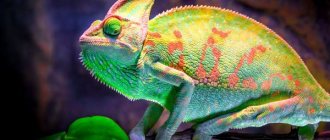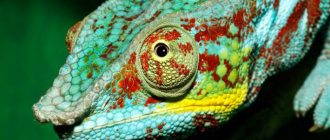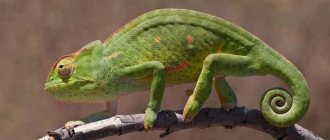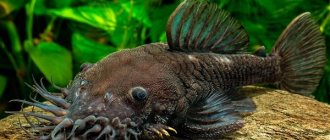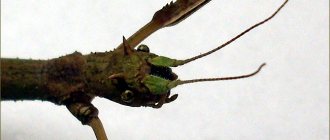- Wild animals
- >>
- Reptiles
The panther chameleon is a brightly colored species of lizard reptile that lives in the rainforests of the Republic of Madagascar. These rainbow "chameleons" are very common in the pet trade, and their popularity lies largely in their distinctive mottled, mottled coat. The creatures change color just like other chameleons, but in a very impressive way. The shades and tones of geographically isolated populations vary enormously from each other, depending on their species.
Origin of the species and description
Photo: Panther chameleon
The panther chameleon was first described by the French naturalist Georges Cuvier in 1829. The generic name (Furcifer), derived from the Latin root furci, meaning “forked,” characterizes the shape of the animal’s legs. The specific name pardalis refers to the color of the animal, as it is translated from Latin as “leopard” or “spotted panther”. The English word chameleon comes from the Latin chamaeleō, a loanword from the ancient Greek χαμαιλέων (khamailéōn) - a compound of two words, χαμαί (khamaí) "on earth" + λέων (léōn) "lion".
Video: Panther chameleon
The oldest described chameleon is Anqingosaurus brevicephalus from the Middle Paleocene (about 58.7–61.7 million years) native to China. Other chameleon fossils include Chamaeleo caroliquarti from the Lower Miocene (ca. 13–23 Ma) in the Czech Republic and Germany, and Chamaeleo ntermedius from the Upper Miocene (ca. 5–13 Ma) from Kenya.
This is interesting! Chameleons are probably much older, having a common ancestor with iguanids and agamids existing more than 100 million years ago. Since fossils have been found in Africa, Europe and Asia, chameleons were certainly more common in the past than they are today.
Although Madagascar is now home to almost half of all chameleon species, this does not suggest that chameleons originated there. In fact, it has recently been shown that they most likely originated on the African mainland. There may have been two distinct migrations from the mainland to Madagascar. Scientists have suggested that the different species of chameleons directly reflect the increase in open habitats (savannas, grasslands and heaths) that accompanied the Oligocene period. The monophyly of the family is confirmed by research.
Arrangement of the terrarium
A properly equipped terrarium will become a home for the chameleon. If you take a small lizard, then keep in mind that it should not be cramped not only for a small one, but also for an older one. Choose a vertical terrarium with a height of 80 cm or more. If you take a female, then maybe a little smaller. The length and width should be approximately 50 cm.
The terrarium does not have to be completely glass. It is optimal if there are mesh walls and ceiling - this is necessary for good ventilation. Heated air should circulate inside and create a favorable microclimate. Chameleons need warmth, so in winter, do not place the terrarium near cold windows and avoid drafts.
To make your pet comfortable and grow healthy, you will need two lamps - one for heating and one for ultraviolet. Using a heating lamp, the required temperature is maintained at 27-29 degrees. A heating point with a temperature of 32-35 degrees will be created around it, where the lizard will come if it wants to warm up.
Experienced breeders advise turning off the lamps after 13 hours and thereby indicating the onset of night. This is the maximum duration of daylight hours, the minimum is 12 hours. At night in the terrarium it should be +22 +24 degrees.
In addition to heat, it is important to maintain the desired humidity - about 50% and not higher than 80%. To do this, in addition to a thermometer, purchase a hygrometer. To keep the chameleon's home humid enough, spray the moisture:
- using an automatic spray system;
- spray bottle - including treating plant leaves with warm water.
A bedding made of coconut husks or other similar material will help maintain humidity levels. If it is too humid, adjust the water supply to prevent mold and mildew from appearing. When choosing a rocky substrate, before placing it in the terrarium, it is first washed with warm water and boiled, or calcined with fire.
The flora in the terrarium can be anything. The main thing is that the chameleon has somewhere to climb and hide. These include plants, sticks, and driftwood.
Appearance and features
Photo: Panther chameleon animal
Male panther chameleons can grow up to 20 cm in length, but the most typical length of the animals is about 17 cm. Females are smaller, about half that size. In a form of sexual dimorphism, males are more brightly colored than females. The body is colored in various shades of blue and green, and sometimes black, with bright spots of yellow, pink, orange and red. Male chameleons often have vertical stripes of red and blue shades on their bodies. Yellowish chameleons are also not uncommon.
This is interesting! Coloration varies depending on location. The different color schemes of panther chameleons are commonly referred to as "locales", meaning the species are named according to their geographic location.
Females tend to remain brown or brownish with shades of pink, peach or bright orange no matter where they are found, but there are slight variations in patterns and colors between different color phases among different species. Males weigh from 140 to 185 grams, and females weigh from 60 to 100 g.
- Feet: The 5 toes are connected in two groups of two and three toes, which give the feet a pincer-like appearance. The group of two fingers is on the outside, and the group of three is on the inside.
- Eyes: They are conical in shape and can rotate freely. Each eye can focus separately on two different objects.
- Nose: Two small nostrils above the mouth, like most other chameleon species. They have white mucus around their nose.
- Tail: Moderately long and flexible. The chameleon can rotate it freely according to its needs.
In keeping with sexual dimorphism, male panther chameleons have small projections protruding from their heads.
Maintenance and care
To adapt a small chameleon, it is better to keep it in a small terrarium at first. For the first six months of life, a terrarium with dimensions of 30 cm long, 30 cm wide and 50 cm high is enough.
After this, adults are transplanted into a terrarium measuring at least 45 long, 45 wide and 90 high. This is the absolute minimum, and, naturally, the more the better.
You need to decorate the terrarium with a variety of live and artificial plants, branches and driftwood. Living plants include ficus, dracaena and other plants.
Chameleons love to climb, and live plants give them the opportunity to do so, plus they feel safe among them.
The top of the terrarium should be closed, as they will easily escape from it. But there must be ventilation, since in the stale air they can catch a respiratory disease, the terrarium must be ventilated.
Where does the panther chameleon live?
Photo: Reptile panther chameleon
Although panther chameleons are native to the island of Madagascar (near Africa), the species has also been introduced to the main island of Mauritius and neighboring Reunion Island, where it has become an invasive species. In Madagascar, this species is found mainly in lowland areas in the eastern and north-eastern parts of the island, ranging from 80 to 950 m above sea level, although it is less common above 700 m.
Panther chameleons live much closer to the forest floor than many other species. They live in the foliage of small trees in areas covered with tropical forests. Their range covers a small range of places, mostly in areas with abundant vegetation. Green cover helps them survive as they are arboreal animals and live exclusively in trees and not on the ground.
These lizards vary in color, and each variant corresponds to a specific area that the species occupied naturally. Panther chameleons are named after the locality they come from, followed by the term "chameleon".
The following types are currently defined:
- Ambanja;
- Ambilobe;
- Ambato;
- Ambodirafia;
- Andapa;
- Ankify;
- Ampiskiana;
- Ankaramy;
- Joffreville;
- Masoala;
- Maroantsetra;
- Nosy Ankarea;
- Nosy Boraha;
- Nosy Radama;
- Nosy Mits;
- Nosy Faly;
- Reunion;
- Nosy Be;
- Tamatave;
- Sambava.
Their natural habitat is coastal tropical forests in the northern regions of Madagascar. Off the island, as pets, they are found throughout the world as pets and as an invasive species in Reunion and Mauritius.
How does a chameleon hunt?
Chameleons are mostly immobile. If you watch the hunt, it may seem that the insects are simply evaporating. This feeling is due to the lightning-fast movement of the lizard's tongue. The chameleon's tongue, capable of shooting at considerable distances, can be considered a real miracle of nature. Basically, the size of the tongue of chameleons is the same as the whole body.
Chameleon hunts
The speed of the beast’s reaction cannot but surprise – there is no comparison with it anywhere in the world. The human eye may not even register the shooting process. The tip of a chameleon's tongue looks like a small arrow, at the end of which there is a small suction cup. The suction cup is moistened with a special sticky solution. Thanks to him, the victim cannot unstick himself and is instantly drawn into the lizard's mouth.
A similar feature of the animal was discovered in laboratory conditions. It was then that it became clear that the chameleon was not capable of grasping wet prey. Thanks to their ability to hunt over long distances, chameleons have excellent sense of distance. Missed victims will not wait for the next shot attempt, so you have to catch the insects right away.
Interesting fact: chameleons hunt during the day only because they cannot change their color while sleeping. This makes them easy prey for predatory species.
What does a panther chameleon eat?
Photo: Panther chameleon in nature
The panther chameleon mainly feeds on a variety of worms that are available in the wild, as well as insects: crickets, grasshoppers, cockroaches, etc. The ambient temperature affects the amount of food eaten. The Madagascar panther chameleon regulates the level of vitamin D3 in its body because... their insect diet is a poor source. To do this, they are exposed to sunlight, as its ultraviolet component increases the internal production of this vitamin.
Interesting fact! Thanks to the unique properties of the eyes, which can rotate and focus separately, viewing two objects at the same time, they receive a full all-round view. When a panther chameleon detects prey, it focuses its eyes in one direction, providing clear stereoscopic vision and perception. This allows them to clearly see small insects from a large (5–10 m) distance.
The panther chameleon has a very long tongue that allows it to quickly capture prey (sometimes its length exceeds the length of the body). It hits prey in approximately 0.0030 s. A chameleon's tongue is a complex system of bone, tendons and muscles. The bone located at the base of the tongue helps to quickly throw it out, giving the organ the initial impulse necessary to capture prey.
At the tip of the elastic tongue there is a muscular ball-like structure, covered with thick mucus, a kind of sucker. Once the tip sticks to the prey item, it is instantly pulled back into the mouth, where the panther-chameleon's strong jaws crush it and it is devoured.
Water
Water is a very important element in keeping a panther chameleon, as they love to drink and need water every day.
The terrarium and chameleon need to be sprayed two to three times a day, thereby increasing the humidity to the 60-70% they need and they can pick up drops of water falling from the decor.
It is better to use drinking bowls or systems that create dripping streams. This will allow the chameleon to pick up water at any time, plus your plants will not dry out.
Features of character and lifestyle
Photo: Panther chameleon
These reptiles are tree dwellers. They move along branches onto large bushes and hunt for their prey. Panther chameleons are extremely territorial animals and spend most of their lives alone in their territory.
Their color changes have various meanings:
- Yellow indicates anger or aggression;
- Light blue/blue indicates that the chameleon wants to impress another individual;
- Green color means a calm and relaxed state;
- Light colors indicate mating intent.
It is a misconception that any chameleon can change color to match the color of its environment. All chameleons have a natural color scheme that they are born with, and this is dictated by their species. It all depends on the temperature, mood and light. If, for example, purple is not in the range of colors that that particular species can change to, then it will never be purple.
Panther chameleon by place of residence:
- The areas of Nosy Be, Ankif and Ambanja tend to be bright blue;
- Ambilube, Antsiranana and Sambava - red, green or orange;
- The Maroantsetra and Tamatave areas are home to predominantly red specimens;
- In addition, numerous other transitional phases and patterns occur in intermediate areas between and within certain regions.
The structure of the legs allows the panther chameleon to firmly hold on to narrow branches. Each toe is equipped with a sharp claw to gain momentum while moving on surfaces such as tree trunks and bark. Panther chameleons can live up to 5-7 years. Although in captivity some specimens appear to live up to years. Males usually outlive females.
To start or not?
Today, the inhabitants of home exoterrariums are a variety of species of lizards: from iguanas to geckos. Some people who like to tickle their own nerves even get huge monitor lizards or snakes. And, of course, the specifics of keeping this pet (temperature conditions, feeding ration, and care nuances) completely depend on who exactly will live in your terrarium. Therefore, it is not enough just to familiarize yourself with the general recommendations for keeping reptiles in the house; you need to study in detail all the available information about exactly the species that you are planning to keep. Indeed, despite their rather repulsive appearance for many people, snakes, iguanas and other creatures in reality are very fragile and vulnerable creatures. This is especially true for chameleons - the strangest and most mysterious inhabitants of planet Earth.
Chameleons are medium-sized insectivorous lizards that most often live on tree branches. The unique ability of these creatures is that they can use camouflage (the color of a chameleon can vary from gray to light green). With such changes in skin tone, it can be extremely difficult to see them in the mass of foliage.
It is this feature that has become a fashionable “trick” of chameleons, which most of all attracts exotic fans to reptiles. This is why chameleons so often become pets to be proud of and show off. However, simply having such a lizard and providing it with the most comfortable living environment is not the same thing. Beautiful creatures by nature have weak immunity and vulnerability to various kinds of diseases - therefore they require especially careful and painstaking care.
Are you ready to create conditions for this creature that ideally replace its usual habitat? Will you be able to take good care of him and devote time to him? These questions are worth thinking about even before you buy a pet.
Social structure and reproduction
Photo: Animal panther chameleon
Panther chameleons reach sexual maturity at least seven months old. Usually the animals live alone and only during the mating season do they spend time with their partners. The female can lay five to eight clutches in her entire life, after which she dies due to the stress caused to the body. These animals are polygamous. The breeding season lasts from January to May. When male chameleons want to mate, they tilt their heads up and down and from side to side.
Curious! In captivity, a female and a male never live together peacefully. The female may even starve to death in the presence of the male. However, two females can be kept together safely, and babies from different females can live together if they are the same age.
When two male chameleons find themselves face to face in a dispute over a female, they become aggressive, change their color and inflate their bodies to appear larger. This is a kind of territorial demonstration. The encounter usually ends at this point, with the loser retreating, turning a dark or gray shade. However, if the encounter does not end in the threat phase, it leads to further escalation and physical confrontations.
When the female lays eggs, she turns dark brown or even black with orange stripes. The exact coloration and pattern of fertilized females varies depending on the chameleon's color phase. Each clutch consists of 10 and 40 eggs. This depends on the quality of food consumed and the subsequent nutrition that the female eats during pregnancy. The time from mating to the appearance of eggs is from 3 to 6 weeks. The hatching of the young occurs 240 days after incubation.
Yemeni view
In its natural environment, the Yemen chameleon lives in the mountain forests of Arabia and Yemen. When keeping this type of chameleon, it is necessary to take into account differences in daily temperatures. During the day the temperature is maintained up to 32 C, at night the temperature is reduced to 25-22 C.
Air humidity is reduced, no more than 30-50%. An animal is not very convenient for a home. It requires a large terrarium. The walls are irrigated with water daily. Chameleons drink by licking liquid from the walls and leaves:
- body length of males 55 cm, females 35 cm;
- Males have a voluminous crest on their heads. It can reach 8 cm in height;
- Males are striped in color. The body has wide, bright yellow and orange stripes. They encircle the body of the animal. Stripes appear almost from birth. In females the pattern is weakly expressed;
- Depending on the situation, the chameleon acquires different shades: turquoise, yellow, orange, green. The color of the stripes also changes. When the lizard sleeps, it turns beige. If she is stressed, then the body will have a predominant dark brown or charcoal color;
- individuals love to bask in the sun.
For animals, a terrarium of 1 m3 is purchased. It contains only one individual. If you plan to mate a pet, then buy a larger container for the mating season. We must always remember that individuals of the same sex do not get along in the same terrarium.
Natural enemies of the panther chameleon
Photo: Panther chameleon
Chameleons are almost at the lowest level in the food chain and have developed several mechanisms for survival. Their eyes move independently of each other, so they look in different directions at the same time. They can also run fast when being chased.
Predators dangerous to panther chameleons include:
- Snakes. They chase the animal in the trees. Species such as Boomslang and Vines are the main culprits of attacks. Boomslangs in particular threaten chameleons because they spend most of their time in trees. They also steal chameleon eggs.
- Birds. They try to grab panther chameleons in the treetops. However, they are not very successful in this, because the animal’s camouflage prevents them from seeing through the foliage. Any bird can grab a panther chameleon, but the main threats are birds of the shrike family, clawed cuckoos and hornbills. The "hawk cuckoo" is also identified as a threat to chameleons. Like snakes, birds can also steal eggs.
- People. The biggest threat to chameleons is humans. Chameleons are victims of poachers and people involved in the exotic pet trade. Pesticides on farmland are poisoning them, and deforestation is reducing habitat. Humans are to blame for the forest fires that are destroying the ecosystem in Madagascar.
- Other mammals. Monkeys sometimes eat chameleons. Although panther chameleons and monkeys do not often live in the same habitat.
How to care at home
Caring for this exotic pet is a big responsibility, so you need to know the intricacies of keeping a chameleon so that it does not get sick or suddenly die.
Selection and arrangement of a terrarium
The main criterion for choosing a terrarium is its size: it is desirable that it be as free as possible for free movement around it. The terrarium can be decorated in different ways.
Important! The female needs a smaller terrarium, but requires a deep layer of substrate (up to 14 cm).
Basic requirements for a terrarium:
- length - on average 60–80 cm;
- width - approximately 60–80 cm;
- height - 50–60 cm;
- volume - 110–130 l;
- provide a tight lid;
- ventilation should be as good as possible, for this it is necessary to tighten the mesh on top on all sides;
- plants, branches, driftwood are needed for a high level of oxygen in the terrarium and to make life more comfortable for the pet.
Comfortable conditions
For a comfortable life in captivity, a chameleon requires:
- humidity should be relative - 50–70% during the day, 80–100% at night, the terrarium should be sprayed in the morning and at night, and even more often, it is advisable to install a small shallow pond where the chameleon can moisturize its skin;
- lighting should be moderate, 2 lamps are installed in the terrarium - UV and incandescent, the first should be turned on for 5-8 hours a day, while the temperature under the lamp is about 5 degrees higher;
- Cleaning the terrarium is necessary to avoid discomfort for the pet once every 2-3 days.
Important! Strong temperature changes greatly undermine the health and negatively affect the life expectancy of the panther chameleon. Normal temperature should be approximately +27 degrees, if at night it drops below +16 °C, then this is very harmful to the chameleon.
Feed and water
The reptile has a complex digestive system and requires constant variety in food so that gastrointestinal diseases do not develop. The basis of the diet is small insects (cockroaches, flies, beetles, crickets). You can also feed worms, small pieces of fruit (bananas, apples). Overfeeding has a detrimental effect on the body. Juveniles eat up to 3, adults - up to 5 insects. Water must be constantly added to the drinker and sprayed on the leaves of the plants.
Communication
Sociability is very characteristic of this species: it can be picked up, stroked, and preferably fed not from hands, but from tweezers. He gets used to people very quickly. Occasionally, due to its individual characteristics, a chameleon may not make contact, but hiss and not let you approach it. Individuals originally bred in captivity have a softer character.
Find out how to keep a chameleon at home.
If you are a lover of exotic things, feel free to get a panther chameleon and you can decorate your living area with such a marvelous, beautiful animal. Attentive care and care will ensure a long life for your pet.
